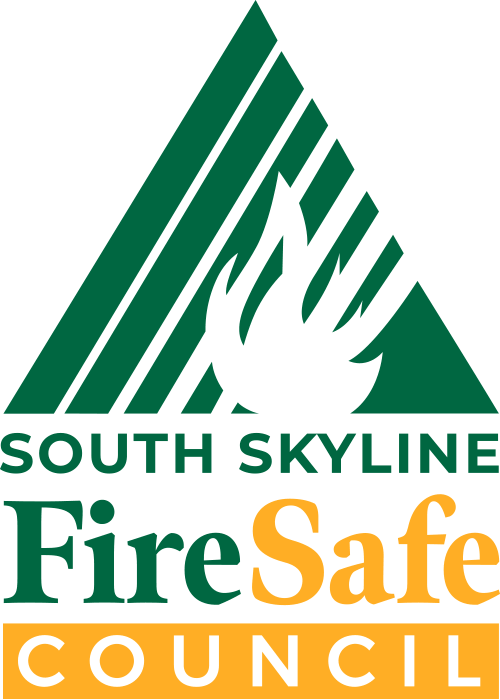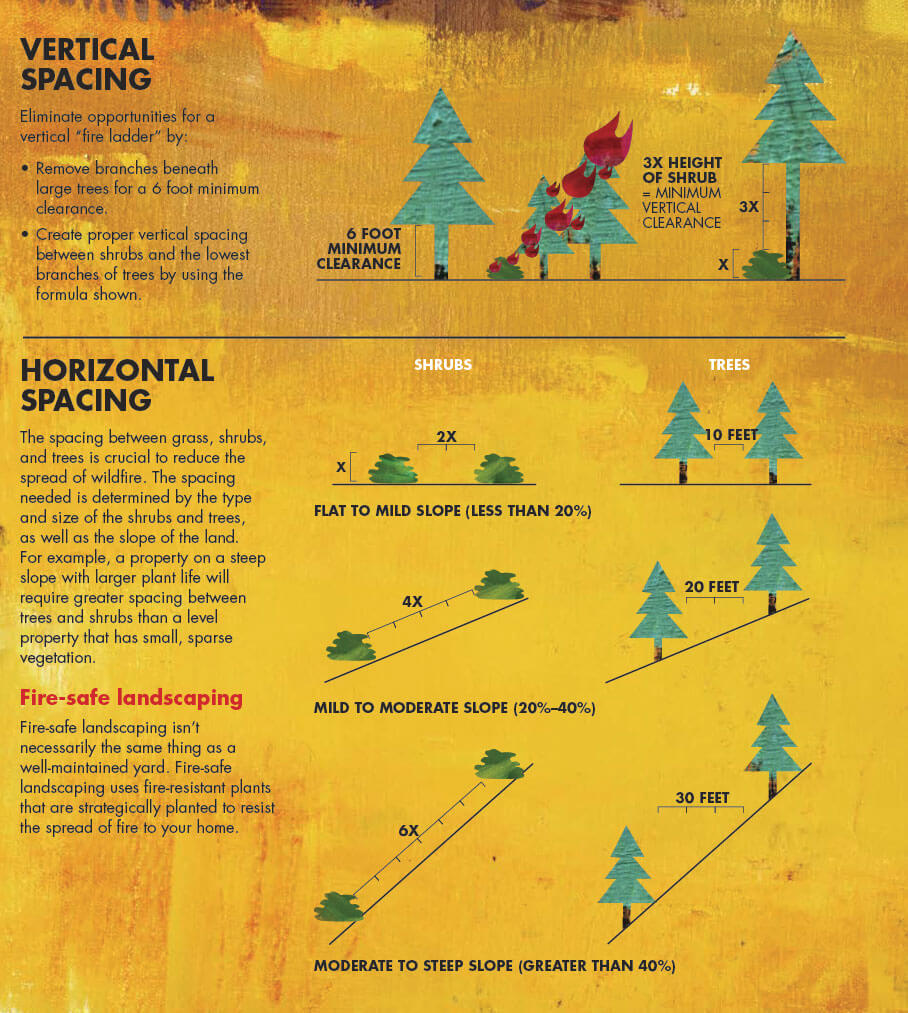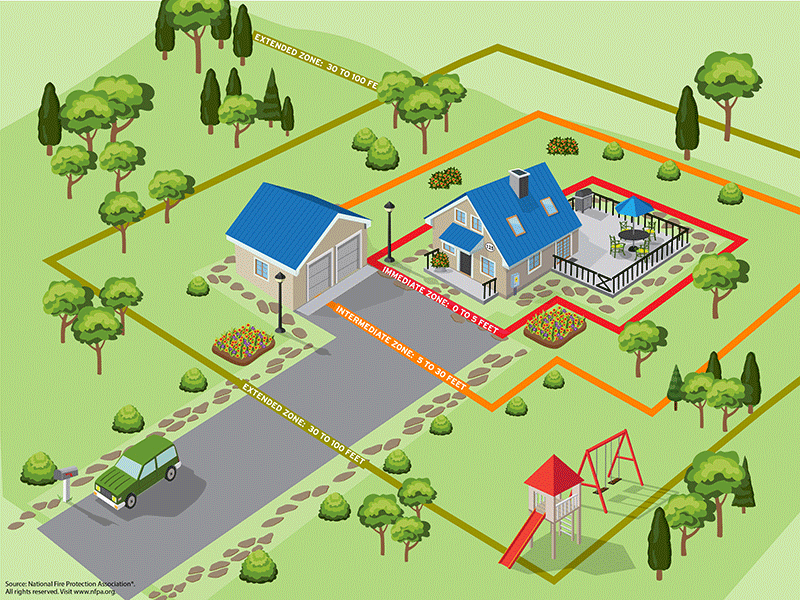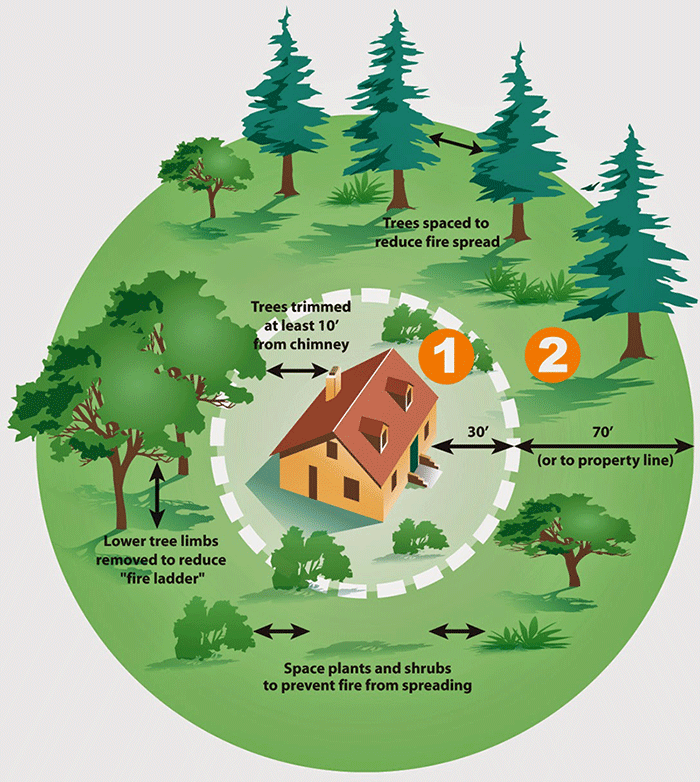Create Your Defensible Space
Large wild land fires throughout Northern California are a big wake-up call for many in the South Skyline community, particularly those who saw the CZU Lightning Complex Fires from their homes! It was also a wake-up call to our insurance companies who are tightening their standards for homeowners insurance. Notices of non-renewal are no longer uncommon (2 months notice seems to be standard). That requires searching for a new insurance company and facing new, updated criteria to qualify for homeowners insurance. Many homeowners are working toward the 100 ft. defensible space required if protected by Cal Fire, by many other fire districts, and probably by most insurers. Defensible space (in combination with home hardening) is critical for making your home and property more fire resilient. Read on to learn about fuel reduction techniques as well as estimating costs to help you choose your best approach for obtaining your defensible space.
South Skyline FireSafe Council conducts assistance programs from time to time, and coordinates with other FireSafe Councils to help homeowners achieve defensible space on their property. Our Free Chipping Program page provides Chipping and Fuels Reduction forms.
Note that the 100 ft. law applies only up to your property line, but insurance companies generally don’t consider property lines when considering defensible space. Midpeninsula Regional Open Space District (MROSD) has establishing a permit process for allowing an adjacent homeowner to extend their defensible space onto Mipen lands.
In a fire storm any fire engine that comes to protect your house will most likely be a large city engine, not the nimble Cal Fire engines which will be off fighting the main fire. Plan to include the clearing of defensible space at least 30 feet on each side of your road/driveway and have an adequate vertical clearance and turnaround for a large engine.
Be sure to mark your fire hydrant with a very visible blue reflector (free from the South Skyline Volunteer Fire and Rescue as advertised in the Skylines). If you have a difficult site to defend, the firefighters are likely to continue on to the next home.
What is Defensible Space?
Defensible Space refers to the area between a house and a possible oncoming wildfire, where the vegetation has been modified to reduce the wildfire threat and to provide an opportunity for firefighters to effectively defend a home.
Sometimes, a defensible space is simply a homeowner’s properly maintained back yard.
From “Living with Fire” in Santa Cruz County: A Guide for Homeowners 2009
Vertical / Horizontal Measurements
Click or tap to view larger image.
Questions?
For more information contact a SSFSC board member. We will try to help you!
Get Involved
Be a volunteer in our SSFSC! Our meetings are at 7:00pm the first Tuesday of the month, variable locations.
Donate
If you think we are doing important work you can also help by making a tax-deductible contribution to:
South Skyline Fire Safe Council
Box 324 Star Rt. 2
La Honda, CA 94020
or use the Donate button at the top of this page. Your donation will be matched by the South Skyline Association.
Clearing: Zones & Subzones
The Home Ignition Zone has three subzones:
- The Immediate Zone (0-5 feet from the home, including the home) This is the zone most vulnerable to embers. Install hard surfaces, use noncombustible landscaping, and don’t store materials under decks. Remove all leaves, fir, pine or redwood needles and combustible garden bark. Leave only bare dirt, hardscape of concrete or gravel, etc. Do not plant shrubs or trees within this 5 foot zone, and especially do not stack firewood against the house or under decks. See information on Hardening the home for more information.
- The Intermediate Zone (5-30 feet from the home)
Use careful landscaping to reduce the continuity of fuels and help slow fire down. - The Extended Zone (30-100+ feet from the home)
Space and prune trees and vegetation to keep flames smaller, lower to the ground, and to interrupt fire’s path.
Clearing: Sizing Space
Sizing the Space to be Cleared
Determine what you think you need to clear (partial or total) to meet the 100 ft defensible space (see illustration on right) and driveway clearance. Review the 20 page pamphlet on defensible space requirements, Living With Fire, A Guide for Homeowners’ that has been handed out at various SSA meetings and distributed with a past ‘Skylines’. Remember, you need a less demanding level of clearance between 30 and 100 ft. (thin out and limb up) than you need in the first 30 ft from your house. While the 100 ft is the law, if you are on or overlooking a hillside you really need more defensible space on the downhill side. Unfortunately, the brochure is a one size fits all and in some situations its clearing descriptions are not very applicable. You may need a trained professional to advise you. Cal Fire Captains and other personnel trained for this are good, but it is inevitable that their recommendations can vary considerably.
How much area are you dealing with? For a house 70 ft. long by 40 ft wide (including decks), the area all around the house out to 30 ft, the well-cleaned area, is about 1/5 acre. The area between 30 and 100 ft is just about 1 acre, 43,560 square feet.
Clearing
What will be the most effective, least expensive way for you to achieve your defensible space, and then maintain it?
The process is easily divided into four parts:
- selectively remove brush and trees
- transport the debris to the collection site
- dispose of the debris by chipping, burning (if in Santa Cruz county), compacting at an out-of-the-way dump site, hauling, or dragging it further into the woods
- maintain the defensible space
NOTE: one option available to public lands managers that is not available to private landowners is prescribed burning. We should encourage prescribed burns on public lands as these increase our security in a severe wild land fire.
Clearing Methods
Chain Sawing
Removing the lower limbs of the remaining trees can be frustrating, particularly those whose branches hang down much lower than at the tree trunk, i.e. fir, and for trees on steep hillsides. A pole saw is most appropriate for removing them. For a small amount of work an electric pole saw which costs about $100 has found it to work well but does not extend nearly high enough. Of course it requires 150 to 200 ft. of heavy gage outdoor extension cord from an outlet. For larger jobs consider the professional pole saw, gas-powered chainsaw on a longer pole runs about $500 and is considerably more effective as it reaches quite a bit higher. Equipment sources include the local lawn and garden equipment stores, and if you are sure about what you are purchasing, the catalogue/on line suppliers such as Northern Tool and Equipment.
Mastication
- Access to the site needs to be evaluated carefully and in close consultation with the contractor. Always check the references provided by the contractor
- Mastication equipment is limited to slopes of less than 40%. Rocky or loosely consolidated side hills may limit use.
- Material coming out of the cutter head can travel some distance and at high speeds. Some of you might remember an experience you had cutting a lawn and having a rock come flying out breaking your neighbor’s window.
Grazing
A different approach to clearing is to use sheep, goats, donkeys, or other farm animals. Sheep are grazers and will eat out the understory of tall coyote bush. Goats are browsers, often preferring the bark on trees to what you want them to eat, are very smart and may seem mischievous. Two of either will clean up and keep an acre of land clean even as you lend them out to your neighbors.
Good fencing is required — options are permanent field fencing, or for goats and sheep, temporary 3 strand electric, or maybe easiest, temporary plastic field fencing with several strands of electric fence woven in. Eventually the smaller animals will need protection from predators. Inquiring around, you probably can find neighbors with animals they will be glad to lend (be wary about agreeing to milk goats!)
Alternately, there are companies that will provide the service of providing the grazing animals including installing the fencing. If you get your neighbors together and have at least 5 acres of brush to clear that option may be worth considering. One such service is Living Systems Land Management.
Disposing
Disposing of the brush, limbs, etc.
If you live in Santa Cruz County you can burn the brush, limbs, etc. Get a burn permit from CalFire and burn on a Monterey Air Quality Control Board burn day. Yet, many in that county choose to chip their brush as being more convenient. Chipping requires that the brush be free of dirt, and it is much preferred that the stuff still be green, not dried out. If you are going to chip, contact the SSFSC (South Skyline Fire Safe Council) as we may be able to group you with others for free/reduced cost for chipping using grant funds that might be available. If that is not available we probably can still help people save money on chipping.
Dragging
Dragging cut debris to a chipping/burning/dump location
To haul brush, tree branches, etc. 100 ft or so on the level or downhill to the disposal site can take as much as 8 times the human effort as it did to cut down the stuff. Dragging it uphill by brute force is much worse. For distances more than about 50 ft. many have cinched up a bunch of brush/small trees with a rope, strap, or chain and pulled it great distances using a pickup truck, any 4 wheel drive vehicle, small (or larger) farm tractor, or an electric winch (don’t overwork it and burn it up!). Using a snatch block (a pulley that can be opened up to insert a rope or cable, available at a hardware store) attached to an intermediate tree one can conveniently pull in a different direction than the brush so the pulling vehicle can stay on hard ground/roads. Be sure the butt ends of everything will all be facing the chipper.
Steep Hillsides
Where there is no access at the bottom of an area to be cleared and the down slope is too steep (as much as 100% slope, 45 degree angle), muscling cut brush up for chipping may not be practicable.
One neighbor did the following: access trails were stepped into the slope at several convenient levels with his small tractor, creating small fuel breaks. The chaparral, small trees and branches he cut between the trails were thrown or dragged downhill to a trail and then crushed by the tractor, pushed to a burn pile site or mixed with dirt while being pushed well back into the forest or ravine for semi-burial far from the home.
Note: Careless/unskilled tractor work on a steep side hill can quickly lead to a deadly roll-over! The live roots between the trails stabilize the slope so erosion is not a problem, but their sprouts must be cut back regularly.
Maintenance
Maintaining the cleared/treated land
If allowed, chaparral will grow back in a few years, negating the original effort. Clearing by chainsawing leaves the stumps in the ground. The fir will not sprout from the stump, but the brush, and bay laurel and oaks will re-sprout and continue to need cutting back every couple years or so. They will protect the slope from erosion. Alternately, painting stumps with an herbicide such as Roundup kills them.
For larger stumps if you or a contractor can get a stump grinder to the stumps they can be ground down to a bit below surface level and covered with dirt. A carbide chainsaw chain should be used if sawing at ground level or cutting out roots. Resproutings from roots of cut brush are best cut back at least every other year. Land cleared of roots can be converted to grassland, native or non-native. If planted at the beginning of the rainy season no watering is necessary.
Non-native annual grasses will need string-line cutting or mowing a couple times a season depending on when you perform the cutting.If you cut the seed heads off prior to maturation, you can reduce their total cover and give those native grasses a hand in the competition game. Remember, grasses like purple needle grass can survive for many years but don’t do well next to non-native grasses. Our native grasses tend to stay green through the summer and typically don’t form continuous compact fuel beds and thus are considered less of a fire risk than annual non-native grasses.
Regulations
A couple of them
First, one is generally supposed to get a permit for taking out any tree over roughly a foot diameter at chest height, depending upon the county or city. Specifically, in Santa Clara County in the Skyline region you need a permit if your lot size is less than 3 acres, but the permit is presently free, and you are not allowed to take out more than 10% of the trees per year. If you live in a forest you may be required to take out some large trees to gain open space between tree canopies.
Can you sell those beautiful logs you may end up with to a sawmill? Probably not, unless they are redwood, as you need a logging permit. This is an expensive (about $7000 in Santa Clara County) and a lengthy process — check with your county or city. Also check with a small logging outfit on how much timber it takes to make it feasible for logging, and consider an outfit with a portable mill that is brought to the log.
Some Costs
The current rate for local ‘bulldozer’ tractor work is about $125/hour, and for a large masticator, $150/hour. A tree service contractor (so should be fully insured) with a large chipper (10 inch diameter or more capacity) with a good crew of two costs $150 to $200 an hour and will probably chip brush nicely piled along a driveway 4 ft. high, 10 ft. wide by 75 ft. long in about an hour. This might be cleared from 1/4th acre of light brush, small trees, and limbs, to 1/10th acre for dense chaparral. You can rent a 6 inch capacity chipper (typically 15 hp air cooled motor) from a local rental yard for about $175/day, but these really are slow, only for small jobs. A large chipper can be rented at about $200 if for more than one day. We hope to arrange for local contract chipping for about $100/hour for efficiently grouped jobs.
If you, like many, are willing to rely on your homeowners insurance for workmen’s comp (homeowners insurers automatically pay into that fund) and liability (read your policy, talk to your agent, and have adequate liability insurance to cover your net worth!), it typically allows for up to 10 hours/week of house and yard help. Unskilled day labor runs $15 – $25/hour and usually works out well for unskilled labor tasks. A good tree person working on his own on the weekend can be found at about $70/hour.



